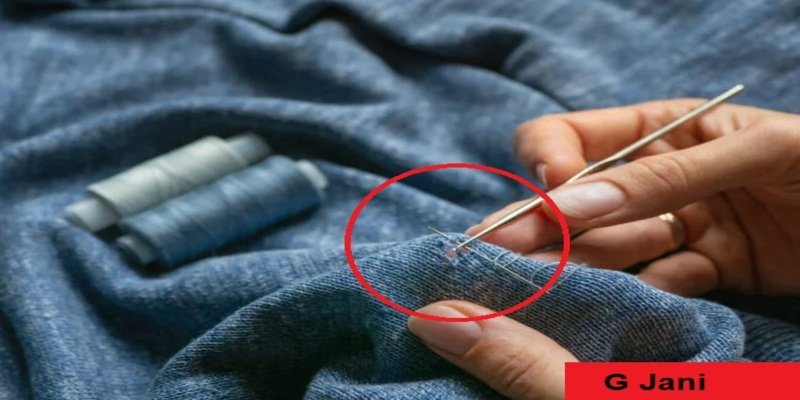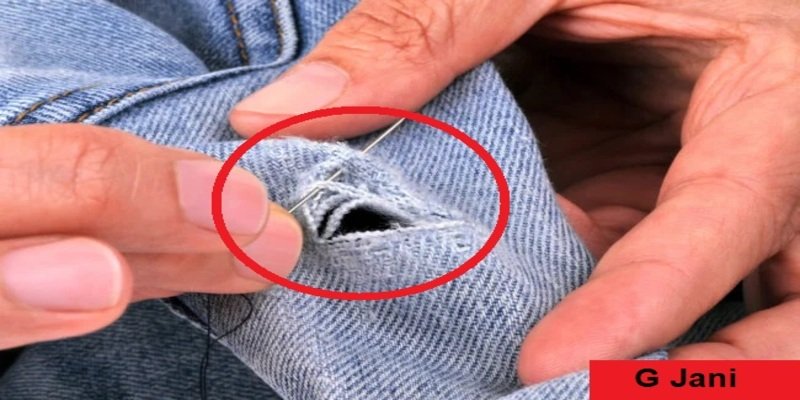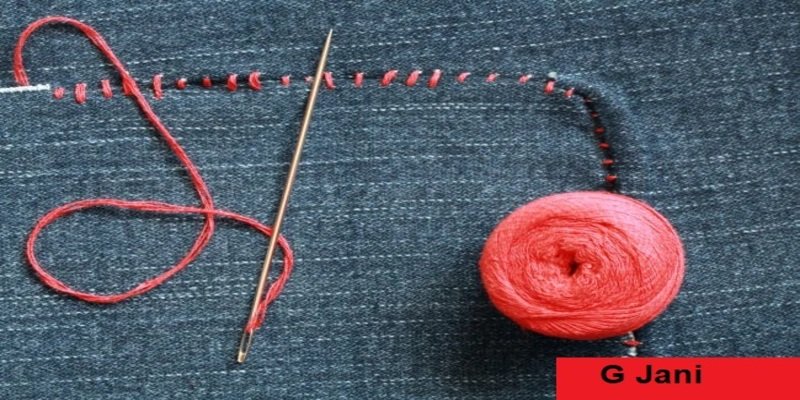A hole in your preferred pair of pants can feel like the end of a time. A slight problem can lead to a wardrobe calamity if not fixed promptly. But have no fear. You do not need to be a major seamstress to patch a hole. This guide will walk you through how to sew a hole in pants into the highest condition.

So bowl up your sleeves, hold a needle and thread, and let’s sew that hole closed.
Tools & Materials

Before you begin, gather your materials. You’ll need:
- A sewing needle
- Matches the threads with the colour of your pants
- A pair of scissors
- A thimble (optional but handy for avoiding pricked fingers)
Ensure you’re comfortable and have good lighting, as precision is vital when sewing. An iron-on patch can significantly reinforce your repair job if you’re working with delicate fabrics.
Step 1: Thread the Needle and Knot the End
First things first, you need to thread your needle. Cut a portion of thread about 18 inches long and fit the end at an angle to help it pass through the eye of the needle. If you are having anxiety threading the needle, try decreasing the thread end or using a needle threader.

Once threaded, take the little tail of the thread and tie a knot. There are a few ways to do this, but the most secure for sewing is the double knot. To connect a double knot:
- Loop the thread around your thumb and twist it so the loop becomes a figure eight.
- Pass the needle through the loop of the figure eight.
- Pull the thread tight, and voila—your knot is secure.
Step 2: Prepare Your Item
Clear the area around the hole and lay your pants on a smooth surface. You may need to wash the pants first to remove dirt and dust, ensuring the area around the hole is clean. If the hole is large, gently press it with an iron to help line up the fabric before stitching.
Step 3: Start Stitching
Start by threading the needle from the inside of the pants, drawing it through so the knot rests on the inside. This creates a hidden knot.

For the first stitch, create a tiny stitch from the inside. Then, directly across from the first stitch, push the needle back through the fabric to the inside, creating a straight line of stitches. Ensure your stitches are evenly spaced and tight enough to hold but not so tight that they gather the fabric.
Securing the Stitch
After several straight stitches, sew a quarter-inch backward before returning to your original stitching. This helps to “lock” the thread and prevent it from separating if one stitch comes loose.
Step 4: Continue Stitching
Keep sewing back and forth until the hole is closed. For larger holes, you may need to use a technique called darning. This involves creating a crisscross pattern with the stitches to reinforce the area. It’s essentially weaving new threads into the fabric to bridge the gap.
Hand sew a hole in pants, place the needle at one end of the hole and bring it up through the fabric. Then, sew a straight line of stitches about a quarter-inch long. When you reach the end, do not go back the other way. Instead, move the needle over and sew another line across the first. Keep sewing lines of stitches in this manner, ensuring you pass over the hole with each new line.
Step 5: Finish Sewing and Tie Off
When sewn as far as needed, create several tiny stitches close together in the same spot. Pass the needle and thread through the loop of each stitch before pulling it tight to make a knot. Do this several times to secure the thread, then trim the excess with scissors.

Alternatives to Hand Sewing
If sew a hole in pants by hand isn’t for you, or if the hole is on a seam, you can use an iron-on patch. Iron-on patches come in all colours and fabrics and are incredibly easy to apply. All you need is an iron and a cloth. Place the patch over the hole, cover it with the fabric, and press the iron down firmly for about 30 seconds. Let the pants cool, and you’re done!
For more advanced repair jobs, a sewing machine can do the job faster and with more strength, but there’s a simplicity and satisfaction in hand-stitching that can’t be matched.
Summary
Sew a hole in my pants or fix a hole in pants sewing is a thoughtful experience. It’s a skill that connects you to the garments you wear and teaches you the value of care and repair. Whether you’re a beginner or a skilled stitcher, the most important thing is to take your time and enjoy the process. Remember, practice makes perfect, and the more you sew, the more repairs you can tackle. In the meantime, happy mending, and may your pants look as good as new when you’re done.
Finally, if you ever want to learn more about sewing basics, there are plenty of funds online, including lectures, forums, and even classes. Sewing is more than just a practical skill. It’s a form of self-expression and creativity. The ability to mend your clothes is not only enabling but naturally friendly too.
FAQs: How to Sew a Hole in Pants: Step-by-step
Can I repair a small hole in my pants without using a sewing machine?
Yes, you can easily sew a small hole in your pants by hand. It may take some extra time and effort, but it is definitely doable.
What supplies will I need to sew a hole in my pants?
You will need a needle, thread, scissors, and possibly some fabric glue or patches depending on the size and location of the hole.
How do I choose the right colour thread for my repair?
It’s best to choose a thread that matches the color of your pants as closely as possible. If you don’t have an exact match, go for a slightly darker shade rather than a lighter one.
How do I prepare the pants before sewing the hole?
First, turn your pants inside out and lay them flat on a surface. Then, carefully trim any loose or frayed threads around the hole to create a clean edge to work with.
How do I secure the thread at the beginning and end of my stitches?
To start, make a small knot at the end of your thread. Then, when you reach the end of your stitches, make another knot and trim any excess thread.

